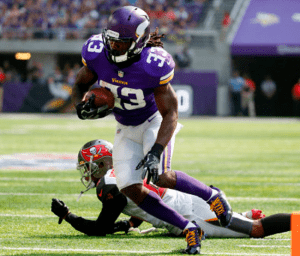Dalvin Cook, Success Rate and You

Through three weeks of the 2017 NFL season, the Vikings offense is 2nd in the league in total yards. They’ve blown out two NFC South teams, and while strength of opponent must be considered, it’s been an incredibly successful start for the offense in spite of a shaky QB situation. Perhaps most oddly, the Vikings are third in the league in total passing, racking up 856 yards and six touchdowns through the air. So how are the Vikings, with a patched together offensive line and largely the same weapons as last year, suddenly start putting up gaudy numbers? And more importantly, is it sustainable?
The answer lies with Dalvin Cook and his ability to keep the team ahead of the chains. ‘Ahead of the chains’ is a phrase commonly used to describe down-and-distance situations. While a 2nd and 5 is manageable, 2nd and 9 is prohibitive. If you’re able to get enough yardage of 1st and 2nd down, making 3rd down manageable, you’re considered ‘ahead of the chains’ and everything gets easier. This can be measured using ‘success rate”, or a yes-or-no tally of whether plays gained enough yardage to stay ahead of the chains. The line is drawn at 40% of 1st down to-gain yardage, 60% on 2nd down, and 100% on 3rd down. It’s a good way to measure running back success because it can’t be skewed by one huge run, rendering the rest of that RB’s day useless. A back who failed on 9 of 10 runs, but happened to bust the one success for 65 yards, didn’t have a good day.
On 1st down throughout these last three games, Dalvin Cook carries have been successful 13 of 31 times, or 41.9%. That means that on 41.9% of the time, the down and distance were manageable, and Pat Shurmur has access to a wider range of his playbook. This may sound like a cliché, but it’s worth illustrating exactly how huge the difference is.
| Dalvin Cook | Stat Line |
| Ahead of Chains | 14 rushes for 70 yards, 5 YPC, 64% Success Rate |
| Behind Chains | 11 rushes for 68 yards, 6.2 YPC, 36% Success Rate |
When Cook has a manageable down and distance, he’s been able to consistently produce successful runs. Behind the chains, Cook has created a good stat-line, but with only 36% success rate, you can see that most of his production came on a few busted plays. By and large, if Dalvin starts behind the chains, he’ll stay behind the chains. It would be unusual not to. To achieve a successful run behind the chains is a higher standard, which is logic that discourages 2nd and long rushes in general.
The difference between ahead-of-chains and behind-chains passing is also immense. When the Vikings are given manageable situations, they can open up the playbook and strike, leading to huge chunk yardage like we’ve seen from both Stefon Diggs and Adam Thielen, both of whom sit in the top 3 for total receiving yards. Splitting Vikings passing stats into ahead-of-chains and behind-chains highlights the difference in difficulty:
| Vikings QBs | Stat Line | Rating |
| Behind | 34/63 for 361, 1TD | 76.22 |
| Ahead | 15/21 for 239, 2TDs | 140.77 |
That stat line behind the chains actually isn’t that bad; Case Keenum and Sam Bradford have both made some clutch plays from behind the eight ball that kept drives alive. But it’s very clear that the large majority of game-breaking plays have come in comfortable situations. Further, these clutch plays can be expected to regress, but probably not to the level that led to 2016’s collapse. In that year, the Vikings were only successful on 38% of their total runs, so Dalvin Cook’s presence has already offered a substantial improvement, especially on 2nd and 3rd down.
It should be noted that the Vikings had about three times as many pass plays from behind the chains as they did when ahead. This makes sense, since the team would rather run the ball in short yardage situations- and why not? Dalvin has been successful in those situations, and already proven he can be trusted.
In a strange twist of events, Sam Bradford’s one game actually featured a better passer rating behind the chains than when he was ahead. But Case Keenum dominates the sample, and normalizes the data.
Dalvin Cook isn’t the only option for 1st down production. Crossing routes, slants, and other West Coast staples are a great tool for creating conservative, yet effective yardage and achieving manageable situations. Those are also great ways to mitigate inconsistency at the quarterback position and shaky offensive line play.
The Vikings have produced in some difficult situations, which is likely to regress. They’ll have to pick up their run game on 1st down to mitigate this, or continue to hit on plays where the situation works against them. These splits illustrate the huge impact that success rate can have, and what the Vikings are truly capable of if they can produce on 1st down. While there’s room to improve, there’s been a measurable improvement in the run game, which is entirely sustainable and should lead to a better offense than the one we were subjected to in 2016.
Thanks for reading!
